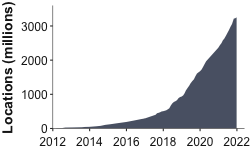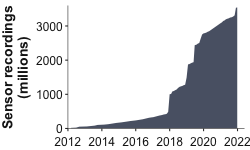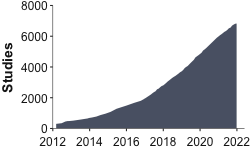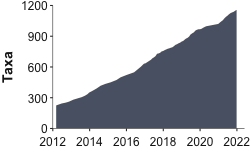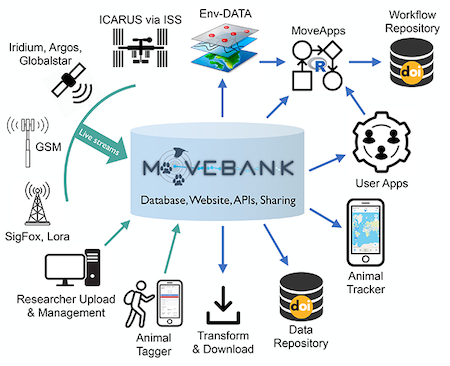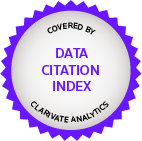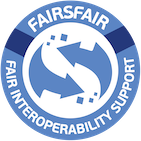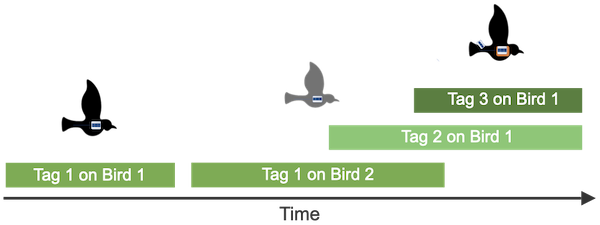February 2022 Newsletter
Dear Movebank users,
We hope the new year finds you well, and are happy to bring you a report of updates and new opportunities at Movebank. Over the past year, your combined efforts continued to grow the amount of animal tracking and bio-logging data supported by Movebank, which now includes 3.3 billion locations and 3.6 billion other animal-borne sensor measurements, representing 1,166 taxa and stored in 6,900 user-managed studies. Together, you added an average of 2.4 million animal locations each day, including data streaming from more than 16,000 tags with live feeds. Over 300 new data owners joined the thousands of researchers using this platform to take advantage of data import and management tools, join group projects and initiatives, or publicly archive their data.
Possibly even more exciting than the growth in data are the creative and exciting ways you are finding to answer questions, make decisions, and work together. In a new paper, “The Movebank system for studying global animal movement and demography” (Kays et al., 2022 (PDF), also summarized in a recent presentation), we provide a comprehensive status report on the suite of services offered by Movebank and how they can be used to understand animal behaviors and demographics, dynamically respond to animal conditions in the field, and build large-scale initiatives that connect projects around the world.
New features & resources
At the top of our list for new features in 2021 is the release of the beta MoveApps platform for customized, no-code analysis of tracking data (more on this below). Other additions we hope will be widely useful include
- New data feeds to Movebank for tracking units from Anitra, Telonics and Wimbitek
- Our first official data feed from Movebank, allowing protected areas using EarthRanger software to bring in their data from Movebank, and expanding the potential to use Movebank for operational decision making
- New options and documentation for your user profile and advice on transferring study ownership between people and accounts
- A set of video tutorials to walk data owners through common data import and management tasks
- Addition of the latest global weather reanalysis from the European Centre for Medium-Range Weather Forecasts (ERA5) to the products that can be annotated to your movement ecology data using the EnvDATA System
- An option to request data in reduced resolution through our REST API to decrease data transfer needs for large projects
- Support for searching animal and tag IDs across studies
- An advanced duplicate filter for custom solutions to cases where one set of duplicate records is more complete or of higher quality
- The option to open the Event Editor for a specified time period, providing more flexibility for data proofing and support for use with entities containing over 500,000 records
- Improvements to the Firetail software to address needs of conservation biologists and researchers, including new built-in AI FireSOM for interactive interpretation of acceleration data, support for more contextual data, and options to export videos and annotation results
- Release of Version 3 of Movebank’s Attribute Dictionary on the Natural Environment Research Council Vocabulary Server, which supports persistent, human- and machine-readable links to definitions for all data stored in Movebank
Finally, we were thrilled to see the first data come into Movebank from ICARUS via the International Space Station, as described in a history of the initiative published in the New York Times Magazine. The test phase of the system is proceeding, with pilot data being collected by tags deployed across a variety of species and regions.
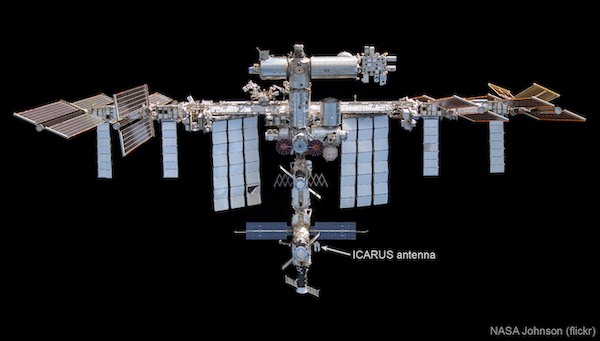
View of the ICARUS antenna on the International Space Station from the SpaceX Crew Dragon Endeavor in November 2021.
(photo by NASA Johnson, flickr, CC BY-NC-ND)
MoveApps
Last spring, we launched the beta version of the MoveApps platform, an open analysis platform for animal tracking data. Through MoveApps, users can design workflows composed of analysis modules, or Apps, to access and analyze data stored in Movebank. Workflows are created using a no-code, intuitive, web-based interface, without need for local download or computing power. Apps, currently all coded in R, are being developed by our team and can be contributed by others writing analysis code. Workflows can be shared privately or publicly, and can be published in a new workflow collection in the Movebank Data Repository. The aim of the platform is to make sophisticated analyses available to a larger audience. Watch this presentation introducing the platform.
Our first Apps (44 and counting) were developed with input from Movebank users and wildlife managers through meetings with government agencies, non-profit organizations, and academic institutions to better understand their ongoing data management and analysis needs. To give it a try, register (it’s free!) and start with one of the public workflows. We recommend the “Morning Report”, for scheduling customized updates about recent animal movements and tag performance, and the “Migration Mapper”, to quickly create and view maps of migratory movements. The user manual offers instructions to build your first workflow and publish your own Apps. For questions and support, contact support@moveapps.org.
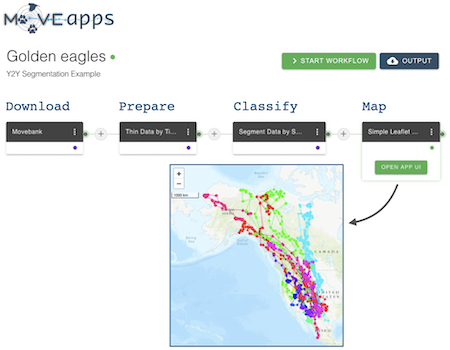
An example of an analysis workflow in MoveApps (data from Smith (2019)).
Animal Tracker
Movebank’s mobile app, the Animal Tracker, has now been downloaded on over 240,000 mobile devices around the world, and has been used to follow over 10,000 animals of 255 species. As use of the app has grown, its “transmitter recovery” feature has become a favorite. Researchers can choose to send out an alert for help locating a stationary tag. After receiving a notification, nearby users can locate the tag and contact the researcher directly through the app to provide photographs, measurements, and other descriptions, or to arrange return of the tag. This feature has a success rate of over 80 percent, resulting in rescued birds caught in urban infrastructure and detailed information about the fates of tagged animals. Nearly 2,800 of these and other sightings have been reported by citizen scientists through the app. For sensitive species with non-public access through the app, optional 2-factor authentication can now help ensure data security.
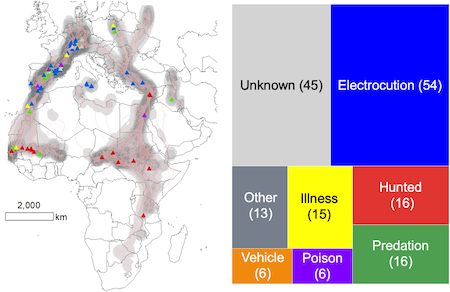
Location and cause of death for 191 white storks tracked with GPS units,
determined with the help of on-site citizen scientists using the Animal Tracker app (Kays et al., 2022).
Data archiving
Movement ecologists cite more than 850 papers and reports describing their data on Movebank, and allow the public to view tracks in or download data from nearly 1,100 studies. Movebank’s public archive, the Movebank Data Repository hosts 266 data packages (42 published in 2021), supporting over 800 authors and 116 journals to document the data underlying research described in 349 written papers and reports. The repository achieved two milestones in 2021, in collaboration with the Open Science Team at the University of Konstanz. First, the repository was awarded CoreTrustSeal certification, a globally recognized credential that identifies trustworthy repositories. Our successful application involved many improvements to procedures and documentation, achieved with support from the European Union FAIRsFAIR project. Second, we are launching a second collection for MoveApps software workflows, allowing users to publish reproducible processing steps for data preparation and analysis to document the results of peer-reviewed research. Published workflows include source code and metadata to support long-term understanding and replication of published analysis methods. In addition, to meet specific institutional and journal archiving requirements, users have successfully published their Movebank data through Zenodo, Dryad, and government archives. When publishing data from Movebank in other repositories, we recommend referring back to your original study in Movebank and Movebank’s vocabulary, as well as adding a reference to your published data in the Study Details of your relevant studies in Movebank. We are happy to provide further advice on how to meet archiving requirements.
Conferences
During 2021 we presented about and represented Movebank in discussions at several conferences. These included (in chronological order) the Annual Meeting of the Virginia Chapter of the Wildlife Society, Arctic Science Summit Week, E-Science-Tage 2021, the 17th Plenary of the Research Data Alliance, the 5th Annual Digital Data Conference, the 7th International Bio-logging Science Symposium, the annual conference of Biodiversity Information Standards (TDWG), and the fall meeting of the American Geophysical Union. We also got a chance to hear from many bio-logging researchers and leaders in related fields. We look forward to more conferences and workshops in 2022, including some in person!
Supporting wildlife conservation
Thanks to support from the Knobloch Family Foundation and NASA, we have expanded efforts to learn how Movebank can best support wildlife management and conservation work. Over the past year, we reached out to over 100 wildlife managers and met with dozens of biologists, wildlife managers and management agencies, non-profit conservation organizations, and regional data management initiatives. These efforts have led to the development and use of new tools on MoveApps, discussions of future partnerships and joint funding proposals. In the fall, we launched a new project, led by the Ohio State University, to develop tools for management and analysis of animal tracking data in the Yukon-to-Yellowstone migration corridor of western North America. In cooperation with seven non-profit and government partners, and ecological statisticians from the University of Minnesota, we have identified data visualization, analysis and sharing needs to promote wildlife management and conservation within this migration corridor, and have begun developing tools on Movebank and MoveApps to address these needs.
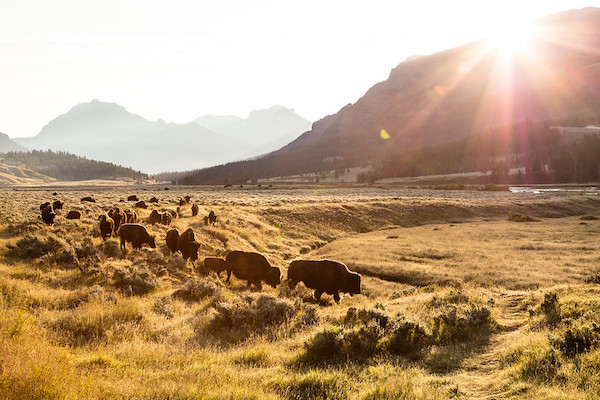
Bison on the move in Yellowstone National Park, USA
(photo by Jacob W. Frank)
Partnerships and shared standards
When we work in isolation, even as a large data platform, we increase the risk that data will not be available for future generations, because they cannot be discovered, accessed or understood. Further, there is unmet potential for bio-logging data to be integrated with other information collected about tracked animals, and with other sources of species observations and remote sensing data. During 2021, we participated in interdisciplinary efforts for shared data protocols through the Research Data Alliance Sensitive Data Interest Group, the TDWG Machine Observations Interest Group, and discussions led by the Global Biodiversity Information Facility on digital extended specimens. Within the bio-logging community, we helped to propose a bio-logging data standardization framework (Sequeira et al. 2021) and look forward to finding ways to move this effort forward. Finally, we are excited to be partnering with the Research Institute for Nature and Forest (INBO) in Belgium on the MOVE2GBIF project to develop prototype best practices and an open-source workflow to publish avian GPS tracking data from Movebank as species occurrence data on GBIF, using bird tracking datasets from INBO and Sovon, Dutch Centre for Field Ornithology, with support from the Netherlands Biodiversity Information Facility.
What could we achieve with easier data discovery and integration across platforms? The Covid-19 Bio-Logging Initiative provides one example. With founding partners representing marine, terrestrial, and avian bio-logging experts from around the world, members are conducting several community-driven, large-scale analyses that will demonstrate the kind of work that could become easier and more representative with better data standards—and identify steps to work towards them. Illustrating the support for such efforts the Initiative was endorsed in 2021 by the United Nations Decade of Ocean Science for Sustainable Development, and received funding in 2020 from the Gordon and Betty Moore Foundation and National Geographic Society. To learn more, watch this update about the Initiative presented at the International Bio-Logging Science Symposium last fall.
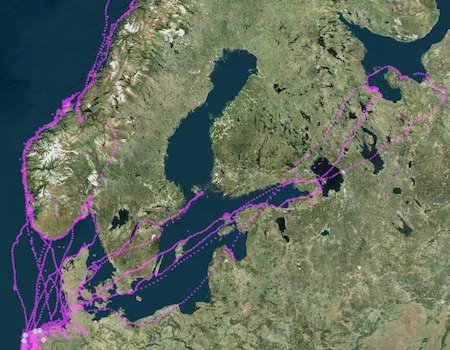
GPS tracks of 189 Eurasian oystercatchers on Movebank will be published on GBIF
as part of the MOVE2GBIF project. (data from Netherlands Institute of Ecology, Radboud University, Sovon,
University of Amsterdam, Vogelwerkgroep Assen)
Tips for data owners
If you have data on Movebank, you may have heard from us during the past year about possible quality issues in your studies. We’re sending these out to help identify and fix common problems, so that you can be assured that your data are organized and can be correctly understood and used by those you share them with. Here are some of the quality issues that can often be identified by looking at your study details:
- Tag data are uploaded but not associated with animals through deployments. (See solutions!)
- Animals have no taxon assigned. (See solutions!)
- Timestamps are not mapped correctly during import. (See solutions!)
Our general best practice tips and the quality control page of the user manual provide further guidance. You can reach our curation team for help at support@movebank.org.
What's next?
Over the next year, we will be completing website updates to help you navigate the platform more easily, releasing data feeds for more manufacturers, upgrading the design and software for the Movebank Data Repository, adding a “geofencing” feature in the Animal Tracker app, and expanding Movebank’s vocabulary in response to user feedback. We also look forward to assisting with and reporting on the progress of several projects led by our partners. Here are open opportunities for those looking to get involved:
- If you develop analysis code, consider publishing your own App on MoveApps. We’ll be offering more training resources and new Apps throughout the year, and you can contact support@moveapps.org with questions.
- If you work or own data within the Yellowstone-to-Yukon migration corridor, consider participating in upcoming training, networking and archiving opportunities as we grow our new project in this region.
- If you have collected data during Covid-19 lockdowns, and are not already partnering with the Covid-19 Bio-Logging Initiative, join us! Several of the initiative's sub-projects are still accepting data submissions. Contact covid19.biologging.initiative@gmail.com for more information.
- If you work in the Arctic or subarctic, join the Arctic Animal Movement Archive by making your data discoverable in this collection or initiating a new project.
- The Max Planck Institute of Animal Behavior's Centre for Animal Marking will be offering an online introduction to Movebank this spring (in German). Register here.
- The AniMove course will be held in September at the Max Planck Institute of Animal Behavior in Radolfzell, Germany. Attendance is being offered first to those who registered for the 2020 course that was postponed due to travel restrictions, and any new openings will be advertised by mid-March. For questions, contact Brigitta Keeves at bkeeves@ab.mpg.de.
- For help archiving data ahead of retirement or as part of data policies, contact support@movebank.org. We can handle anything from piles of Excel files to drafting data-sharing agreements.
We are also excited to hear about your own ideas for projects and cooperation! We continue to be amazed by the effort and support from researchers and organizations using Movebank. To stay in touch, find us on Twitter, Facebook, YouTube, or contact us directly at support@movebank.org.
Sincerely,
The Movebank Team

